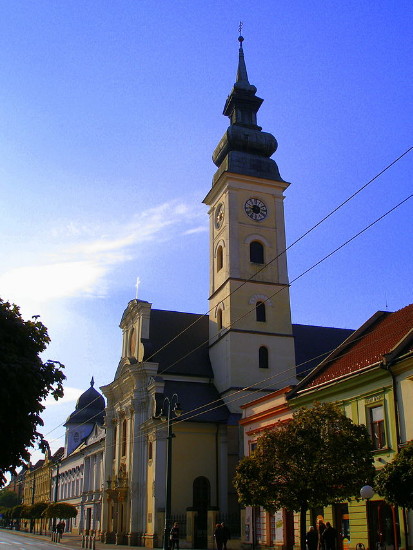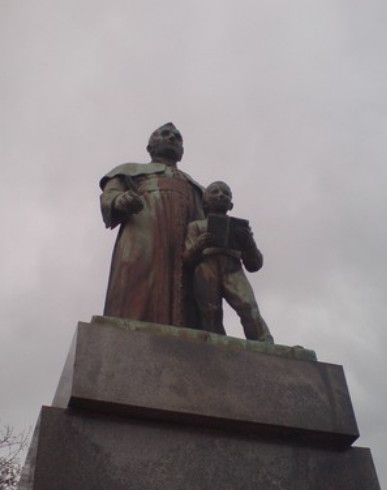Prešov
Prešov [Ukrainian: Пряшів; Priashiv]. See Google Map, see EU map: IV-2. A city (2021 pop 83,897) in eastern Slovakia, situated on the Torysa River, with approximately 2,000 Ukrainian inhabitants. In 1935 its population was 22,000, of whom 2,500 were Ukrainians. A transit point for trade between Galicia and Hungary from the Middle Ages on, it was mentioned in a document of 1247 as an important city. It later became the center of the Sáros (Šariš) komitat. Although not within Ukrainian ethnographic territory, the city has developed as a Ukrainian center. In 1816 it became the capital of a Greek Catholic Prešov eparchy, of which the first bishop was Hryhorii Tarkovych. The city’s cultural significance for Ukrainians grew in 1850, with the establishment of the Prešov Literary Society by Oleksander Dukhnovych. Active until 1853, the group had 72 members and published nine books (including textbooks and three issues of the almanac Pozdravlenie rusynov, 1850–2). The John the Baptist Society, a charitable and educational organization, was founded in the city in 1862. A hostile attitude toward national minorities by local authorities and the prevailing Russophilism or Magyarophilism of the local intelligentsia (particularly among the clergy) retarded Ukrainian cultural growth for decades. It was given new impetus only when the Prešov region joined Czechoslovakia in 1919. Nevertheless, because no administrative ties were established with Ukrainian regions of Transcarpathia, cultural development continued to proceed slowly. There were a number of Russophile organizations and institutions active in the city, including the Russian People’s Council, the Russian People’s Home, the Russian Club, the Russian Museum, the Dukhnovych Society (est 1933), the Union of Russian Women, and the Union of Russian Teachers.
Russophile newspapers included the clerical Russkoe slovo (Prešov) (1924–39), Narodnaia gazeta (1924–35), and Russkaia narodnaia gazeta (1937–8). Slovo naroda was published in Ukrainian in 1931–2 and edited by I. Nevytska.
A Greek Catholic theological seminary (est 1880), teachers' seminary (1895), and gymnasium (est 1936) were also active. A Ukrainian radio program began broadcasting locally in 1934 and has continued serving the region to this day.
In 1945 Prešov was recognized as the offical center of the Ukrainian population in Czechoslovakia, and the Ukrainian People's Council of the Prešov Region was established there. The new body sponsored several publications, including the newspaper Priashevshchyna. In 1946 the Prešov Ukrainian National Theater, which has staged over 300 productions in Ukrainian and Russian, was established. In 1951 the Cultural Association of Ukrainian Workers was formed, and succeeded the Ukrainian People's Council. After the Velvet Revolution in 1990, it changed its name to Union of Ruthenian-Ukrainians of the Slovak Republic. In 1951 Priashevshchyna was replaced by the weekly Nove zhyttia, the illustrated monthly Druzhno vpered, and the literary quarterly (now a bimonthly) Duklia. In 1952 a Ukrainian branch of the Slovak Writers' Union was established in Prešov. A department of Ukrainian language and literature at the Prešov division of Košice University, an Orthodox theological seminary, a Ukrainian elementary and primary school, and the Duklia Ukrainian Folk Ensemble are also found there. Greater numbers of Ukrainians have entered Prešov’s intelligentsia in recent decades. Since 1950 the city has been the center of an Orthodox eparchy, and in 1969 it became an ordinariate of the revived Greek Catholic church. The Ukrainian department of the Slovak pedagogical publishing house annually publishes 12 to 15 Ukrainian works of literature or scholarship and a comparable number of textbooks. The local Ukrainian intelligentsia was particularly active in the latter 1960s, but after the 1968 invasion by the Soviet Union a number were dismissed from their posts, including Yurii Bacha, Yeva Biss, Ivan Matsynsky, Mykola Mushynka, Pavlo Murashko, and Y. Shelepets. Most were rehabilitated in 1990. In 1989 the Ukrainian gymnasium was renamed the Shevchenko Gymnasium.
In the 1960s to 1980s, a number of conferences on the works of Oleksander Dukhnovych, Ivan Franko, Fedir Lazoryk, Ivan Pankevych, Oleksander Pavlovych, Taras Shevchenko, and other Ukrainian cultural figures were held in the city. An academic society in Prešov is affiliated with the Union of Ruthenian-Ukrainians of the Slovak Republic. Ukrainian departments are situated at the regional pedagogical institute and the Pedagogical Research Institute.
Ukrainian editions of the monthly (Orthodox) Zapovit sv. Kyryla i Mefodiia and (Greek Catholic) Blahovisnyk are published along with the Slovak versions. (See also Prešov region.)
Mykola Mushynka, Orest Zilynsky
[This article originally appeared in the Encyclopedia of Ukraine, vol. 4 (1993).]


